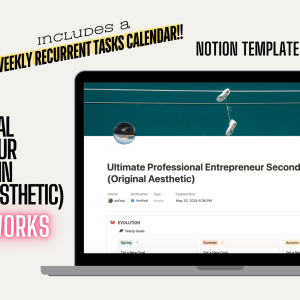Best Practices for Maintaining Your Social Media Calendar Template

Maintaining a consistent and organized social media calendar template is essential for businesses and individuals to have a good online presence. A well-maintained social media calendar ensures that you post regularly and helps you plan your content strategy, track performance, and engage with your audience effectively. Let’s see how you can do that in the best way possible.
1. Understand the Importance of a Social Media Calendar
It’s important to understand why a social media calendar is super important:
- Consistency: Regular posting helps maintain audience engagement and brand visibility.
- Organization: It allows you to plan and schedule content in advance, reducing last-minute stress. Besides, you can have more control over what topics you post and when.
- Strategy: Helps you align your content with your marketing goals and audience preferences.
- Analytics: Facilitates tracking and analyzing the performance of your posts. You need to understand what works and what doesn’t work!
2. Choose the Right Tools
Selecting the right tools is the foundation of an effective social media calendar. The Ultimate Social Media Planner Notion Template is a great tool that can help you streamline your social media management. Here’s why it stands out:
- User-Friendly Interface: It uses Notion’s intuitive design, making it easy to navigate and customize. It also has a very happy design to make your work lighter.
- Centralized Platform: Manage all the strategies for your social media platforms in one place.
- Competitor’s Analysis: It also integrates a competitor’s analysis, so you can see how you compare to them.
3. Set Clear Goals and Objectives
Define what you want to achieve with your social media efforts. Setting clear goals and objectives will guide your content creation and posting schedule. Common social media goals include:
- Increasing Brand Awareness: Growing your follower base and reach.
- Driving Traffic: Directing users to your website or landing pages.
- Engaging with Your Audience: Fostering interactions through comments, likes, and shares.
- Generating Leads and Sales: Converting followers into customers.
4. Plan Your Content in Advance
Advance planning is key to maintaining a consistent posting schedule. Creating a plan with one month in advance will allow you to have a bigger picture. But remember to be flexible! Sometimes, you need to change things.
- Monthly Overview: Use your social media calendar to outline a month’s worth of content. This helps you visualize your strategy and ensures a balanced mix of posts.
- Content Themes: Assign themes or topics to each week or month to maintain variety and relevance.
- Important Dates: Include holidays, industry events, and significant dates that are relevant to your audience.
- Be Flexible: Sometimes, some trends affect your industry, and you can capitalize on them. Use the opportunity!
5. Diversify Your Content Types
Variety keeps your audience engaged and caters to different preferences. Incorporate various content types into your calendar, such as:
- Educational Posts: Share tips, tutorials, and how-to guides related to your industry/topic.
- Promotional Content: Highlight your products, services, and special offers.
- Engagement Posts: Ask questions, create polls, and encourage user-generated content.
- Behind-the-Scenes: Give a glimpse into your company culture or personal life.
- User Testimonials: Share reviews and testimonials from your satisfied customers.
However, remember that certain content works best on a different social media platform. When you plan your content, assess where a post might work best.
6. Leverage Visuals
Visual content is more engaging and shareable than text-only posts. Think about Instagram: reels work like magic! Ensure your calendar includes a plan for visual elements according to each social media platform:
- Graphics and Images: Use tools like Canva to create visually appealing graphics.
- Videos: Plan for video content and take your sweet time for it. Even if the video is simple, it will reach better results if you make it sweet and bold.
- Infographics: Create infographics to present data and information visually appealingly.
7. Schedule Posts
Scheduling your posts in advance ensures that your content is published at optimal times, even when you’re busy. I highly recommend Metricool [affiliate link], the social media management tool I use.
- It allows you to manage five brands for a very low price. Each brand can monitor different social media platforms!
- You can use it for yourself and your clients!
- You can plan all your posts for all the social media platforms you’ve chosen.
- It offers a lot for a very low price.
- And it has affiliates.
8. Monitor and Analyze Performance
Regularly monitoring and analyzing the performance of your social media posts is crucial for refining your strategy. You need to take a look at:
- Key Metrics: Track metrics such as engagement rate, reach, impressions, click-through rates, and conversions.
- Analytics Tools: Compare the analytics from Metricool [affiliate link] with those of each social media platform to get a better view of what’s happening.
- Adjust Strategy: Use the insights gained to tweak your content strategy, posting times, and overall approach.
9. Engage with Your Audience
Engagement is a two-way street. Actively interacting with your audience helps build a loyal community. This means that you can’t ignore your audience. Take time to:
- Respond to Comments: Reply to comments and messages from your followers. Again, Metricool allows you to do that from it! There is no need to go to each place to answer people.
- Encourage Interaction: Ask questions, create polls, and encourage your audience to share their thoughts.
- User-Generated Content: Showcase content created by your followers to build a sense of community and appreciation. For example, that’s what I do with AI Mixer.
10. Stay Updated with Trends
Social media constantly evolves, and staying updated with the latest trends can give you a competitive edge. I know it can be daunting, but…
- Industry News: Follow industry blogs, news sites, and influencers to stay informed about the latest trends. I use Apple News for that. I set up the venues I follow there and always stay current.
- Platform Updates: Regularly check social media platforms for updates and new features. This one is a bit trickier if you have to manage everything on your own. The trick is to set up a time to take a look. (It’s better to do this weekly.)
- Experiment: Don’t be afraid to try new content formats, tools, and strategies.
11. Collaborate with Your Team/Clients
Collaboration is essential for maintaining a cohesive social media strategy if you’re working with a team. Here are some tips:
- Assign Roles: Clearly define roles and responsibilities within your team.
- Regular Meetings: Meet regularly to discuss progress, challenges, and upcoming content.
- Shared Calendar: Use the Ultimate Social Media Planner Notion Template to keep everyone on the same page.
You don’t need to pay much for Notion [affiliate link]! The plus plan allows you to invite 100 guests! If you’re a solopreneur and are working with clients, that’s quite a good number!
12. Review and Revise Your Calendar Regularly
The calendar won’t work magic on its own! You need to regularly review and revise your social media calendar to ensure that it remains relevant and effective.
- Monthly Reviews: At the end of each month, review your posts’ performance and make necessary adjustments. What worked? What didn’t?
- Weekly Review: If you don’t want to have a bunch of work at the end of the month, review your social media calendar weekly and adjust it at the end of the month to see what worked.
- Flexibility: Be flexible and willing to adjust your calendar based on new insights and changing circumstances.





